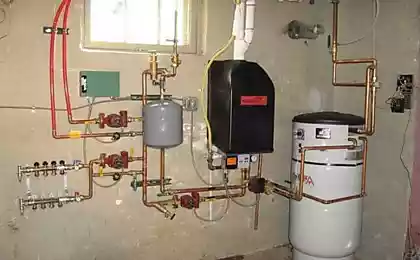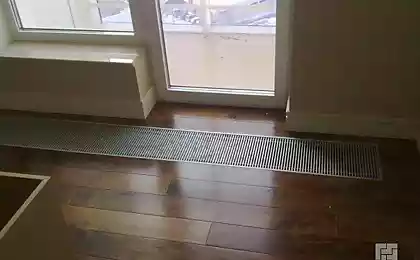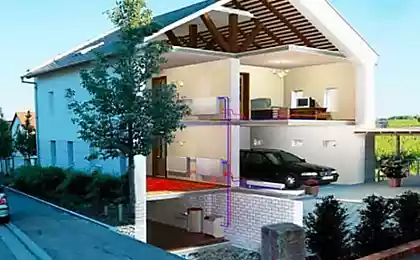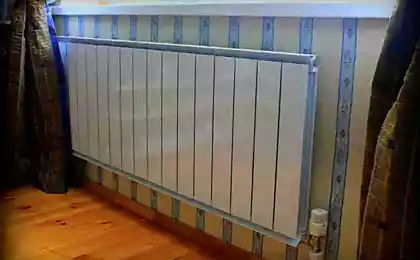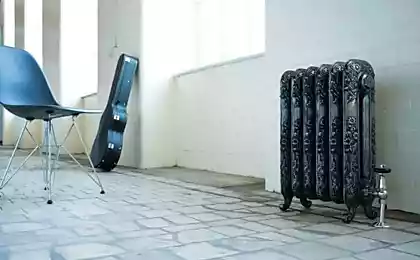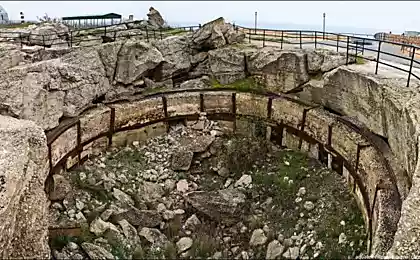596
Options for disguising radiators in the house
Unfortunately, the appearance of even the most modern heating devices not always meet aesthetic requirements, sometimes can't fit in the interior space. The desire of the owners to eliminate this drawback is completely natural. Before closing the radiator, you should understand all the intricacies of the issue. Otherwise, the cost of heating homes can significantly increase.
Camouflage radiators and the laws of heat
The main objective of any radiator is to heat the premises. The object is achieved by a combination or individual use of two methods – infrared radiation, and convection. Thanks to them, formed a comfortable environment. Infrared radiation provides heat transfer to objects in space, convection — it heats the air.
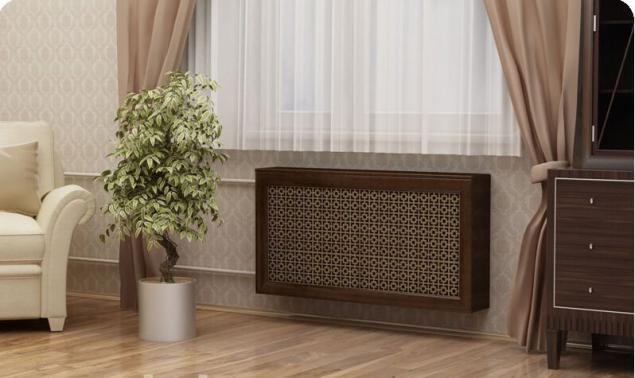
Thermal energy we can feel, if you place a hand close to the radiator. Convection provides air circulation and uniform temperature distribution throughout the room. It is known from school physics course – warm air rises, it displaces cooler.
You need to understand that virtually any method of hiding pipes and radiators will lead to imminent loss of heating power. The easiest example is the use of glass screen with decorative painting. It would seem that the task of decorating the radiator is successful, but the room became noticeably colder. It all happened because glass almost completely eliminates infra-red radiation.

The deeper and more reliable will be hidden behind the radiator, the greater will be the loss. This statement fully applies to the deaf screens that prevent as far infrared radiation and high convection.
The same can be said about blind boxes over the top of the radiator — they are an insurmountable obstacle to the spread of warm air up (not working method convection). The conclusion is clear – the larger the holes in the plate, the smaller the heat loss.
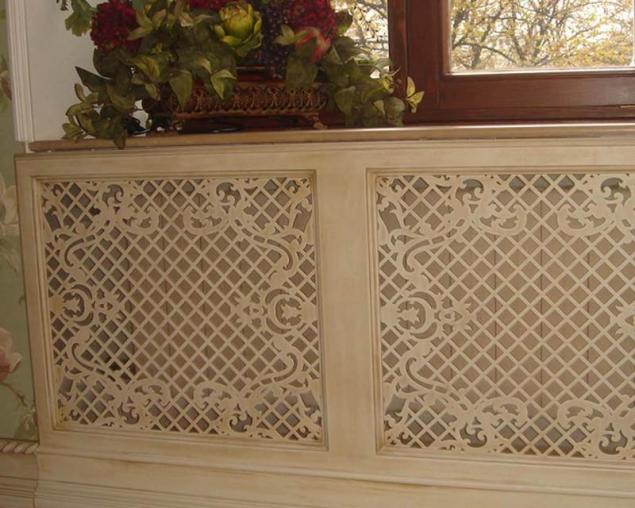
Requirements for decor radiators
The availability of tubes and batteries is another important aspect in choosing the decor after the requirements of heat engineering. It is well known that a radiator, and a personal connection to the pipe is the weakest. In addition, the radiator caused by improper installation and operation, or because of other reasons, may leak.
In an emergency, you may need to remove the radiator for repair or replacement. From the standpoint of the sanitary, pad or screen should not have a fixed mount, ideally using side screens.
Even if You decide to ignore the advice of plumbing, still listen to the Glossa of the mind, which dictates that any weak point of the system are the nodes of the connection. The presence of an audit (plastic doors) can greatly simplify the maintenance task of the radiator and the heating system in the future.
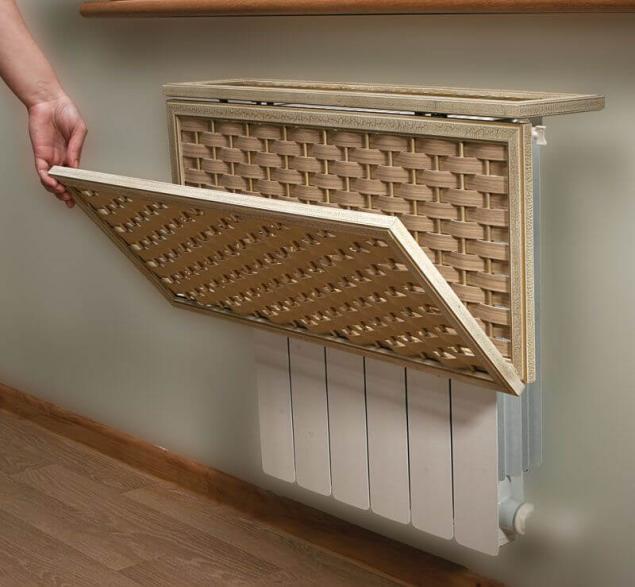
Ways of masking radiators
Ways to close radiator known a great many. To pick the best option, though not easy, but it is possible. Let's start with the most simple and the most affordable ways.
Painting budget solution
From the point of view of the designer it is very important the combination of colors. Most often, the radiator is painted white, a poet on the walls of bright colors it will be almost invisible. If the walls are a solid dark color, here too, no problems. It will be enough to pick up heat-resistant paint of the desired color and carry coloring of the radiator. If we fail is to get in tune, then it wouldn't be terrible except for a few notes on the General background to be almost invisible.
If the Wallpaper have a pattern, and the radiator need to do to become them. Most often one or two of the walls have patterns, while others are finished with Wallpaper of different textures in a single tone. In this case, balances all of the Wallpaper must be cut into strips and stick them on the radiator. The thickness of the stripes and the striping should be selected on the spot by experience, trying to get a drawing most harmoniously fit into the interior of the room.
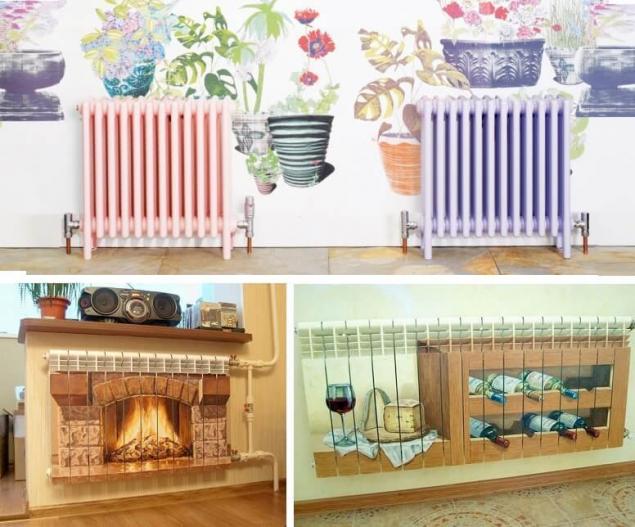
If we are talking about masking the radiator in the nursery, you can unleash the imagination and paint them to match the surrounding interior. Ready-made templates will be handy in case of a lack of experience with a brush. Don't forget that you need to use heat resistant paint.
Photo 3. The use of stencils, templates, and ready-made labels greatly facilitates the process of decorating the radiator.
The use of fabric as a screen
Another proven and very successful way of masking the radiator is "blind to gender". Earlier this method was the most simple and popular due to the fact that the heavy blackout curtains were in fashion. It is now customary to use a thick fabric, which is attached with Velcro to the wall or window sill.
It is best to mount the curtain from wall to wall, the light curtain it will look great. Similarly, you can do that, replacing curtains vertical blinds.
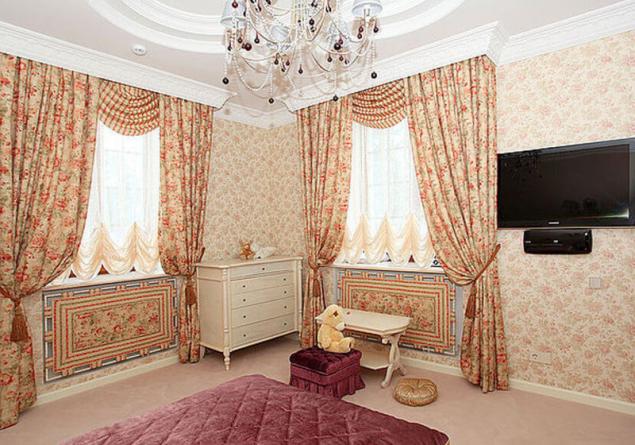
The use of fabric as a screen
One of the most simple ways of closing the panels is the use of side screens. For their manufacture can be used a variety of materials or entire mix.
However, we must note that by itself, the screen wall may look ridiculous, so you need to fine-tune its appearance and properly fit into the interior. The store will not be difficult to find ready made screens and close the radiators.

The most widespread are the following types of screens:
1. The metal screens. As a rule, is used for its manufacture stainless steel or chrome elements. These products are characterized by good conductivity and durability.
At a relatively low cost and good functionality, their appearance leaves much to be desired. No additional finishing such screens suitable for the decoration of the room in the style of hi-tech.
2. A wooden screen. This option is the most win-win, because the tree easily fits into the interior of almost any room. It is best to purchase a standard screen, and make it to order. The appearance of a wooden screen should match the style and color of furniture or be a part of it.
The appearance of wooden screen reminiscent of a wicker grill and it looks impressive and stylish. Best wooden lattice is suitable for masking the battery, located under the window. This design with a sufficient number of holes does not prevent the penetration of warm air and ensure good convection.
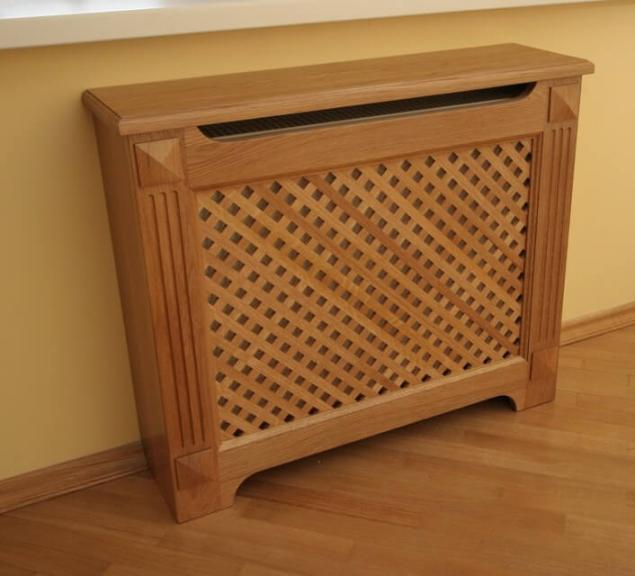
3. The glass screen. Decorative glass gives any room a look of lightness and ease. Premises with glass screen, decorative glass take the form of grooming and completeness. True, along with a striking appearance this screen conceals a significant drawback.
When using the glass screen is almost twice reduced heat transfer. So you have to choose between effectiveness and efficiency. If you approach the question properly, it is best to use the screen from decorative glass panels – so it will be made of appropriate hiding effect and ensure maximum conductivity.
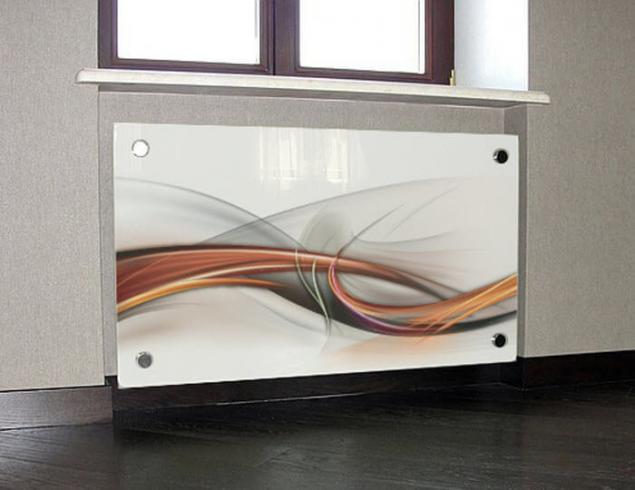
4. The screen of the drywall. If earlier it was about screens like on the finished product, the screen of plasterboard can be made independently. The screen of the drywall is considered the budget option. Make it under the force of each, and pinning with subsequent finishing should not cause special difficulties.

How to make a screen out of drywall
As an embodiment of the screen of plasterboard is the most versatile, the device will take a closer look. To create and screen installation you'll need the following tools and materials:
Work on the device screen of the drywall starting with the frame. For its production it is necessary to cut the rails UD profiles and fasten them with screws to the floor and windowsill. To the screen surface coincided with the surface of the wall frame you need to drown to the thickness of the drywall plus the thickness of the finish. Usually, this value is 13-14 mm.
Next, you need to fix CD profiles, it should be noted that the distance between the vertical profiles should slightly exceed the size of the lattice. Armed with a pencil and a tape measure should be applied to the sheet sizes of the workpieces and cut them with a utility knife.
Cutouts should be screwed to the frame with screws. The consolidation should be done very carefully, as excessive penetration of the caps of the screws may occur rupture of the sheet of drywall. It is to fix the grill and make the finish screen.
Boxes for radiators
Boxes that hide the battery, it is best to arrange for the repair or installation of the heating system. For the manufacture of boxes suitable for following materials:
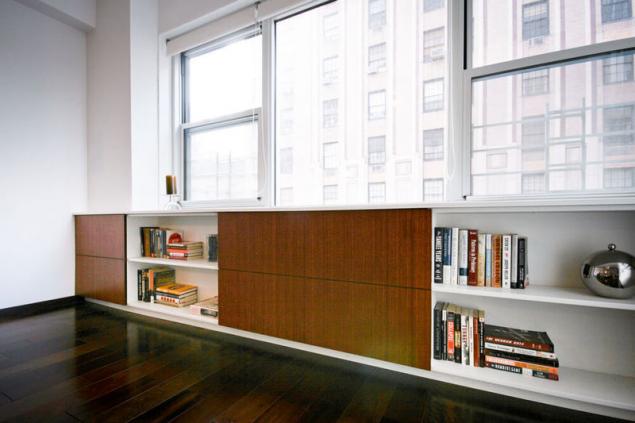
Aesthetic load boxes are more difficult to implement, but doable. The radiator, located near the wall can decorate for the fireplace. In this case, it is not necessary to use the brickwork and installation of wrought iron lattice. You can do much easier and to make the box from the cut sheet of plywood or fiberboard.
After fixing a wooden slatted frame and installation cut sheets of plywood left to paste over the fireplace with a film. You can go ahead and stick inside the fireplace painted flames or embers, it all depends on Your flight of fancy.
Installation of batteries in the wall
One of the most time-consuming ways of disguising the radiators and heating pipes is implemented at the stage of construction or overhaul. This method considers the location of pipes and radiators on the wall, and inside her. Of course, this will inevitably lead to a reduction of the useful area of the premises and the increase in heat loss, but there is no need to puzzle over how to decorate the radiators and heating pipes.
You can go even further and completely abandon the radiators and pipes, replacing them with warm floors. If the heating effect is insufficient, it is possible to add heating system convectors-invisible, thru furniture, window sills, plinth, floor, etc.
Disguise battery is in the bathroom and kitchen
In the bathroom it is best to hide the radiators in any furniture. Better suited for this wall lockers. If for any reason you cannot hide a radiator in the cupboard, it is better not to resort to the manufacture of hinged boxes. They will awkwardly look on the wall. In this case it's better just to paint the radiator to match the walls.
With regard to the placement of the radiator on the floor, we can restrict the installation screen.For the manufacture of a screen suitable MDF and plastic, it can also be a glass and chromed metal – these materials blend well with sterile clean and Shine ceramic tile.
In the kitchen most often mask the radiator under the window sill-countertops. This technique allows not only hide the radiator, but also greatly increase work surface. If we are talking about a small apartment, then this technique can be considered a significant bonus. Here it is difficult to argue which aspect is more important – functional or aesthetic.

There is still the option to install a folding table. In this case, the color of the countertops and wall color should be the same. The disadvantage of this design is the inability to make design countertops perforated. The presence of crevices between the countertop and floors, and between countertops and window sill will help to ensure proper convection.
When performing masking any of the offered methods it is not necessary to forget about the main functional task of the radiator is the heating and distribution of heat. Improperly selected material, the scheme of the setup and decorating can several times to increase heat loss.
Do hide and hide battery in plagiocephaly apartments, in principle, should not, why did they even paint often, because the heat transfer is significantly deteriorated. But if the boiler heats hot, you can hide the battery. I prefer to approach this case without fanaticism, a simple screen is enough. And remove easily for cleaning dust and very wise design is not necessary. published
P. S. And remember, only by changing their consumption — together we change the world! ©
Source: sovet-ingenera.com/otoplenie/radiator-obogrev/chem-zakryt-batareyu-otopleniya.html
Camouflage radiators and the laws of heat
The main objective of any radiator is to heat the premises. The object is achieved by a combination or individual use of two methods – infrared radiation, and convection. Thanks to them, formed a comfortable environment. Infrared radiation provides heat transfer to objects in space, convection — it heats the air.

Thermal energy we can feel, if you place a hand close to the radiator. Convection provides air circulation and uniform temperature distribution throughout the room. It is known from school physics course – warm air rises, it displaces cooler.
You need to understand that virtually any method of hiding pipes and radiators will lead to imminent loss of heating power. The easiest example is the use of glass screen with decorative painting. It would seem that the task of decorating the radiator is successful, but the room became noticeably colder. It all happened because glass almost completely eliminates infra-red radiation.

The deeper and more reliable will be hidden behind the radiator, the greater will be the loss. This statement fully applies to the deaf screens that prevent as far infrared radiation and high convection.
The same can be said about blind boxes over the top of the radiator — they are an insurmountable obstacle to the spread of warm air up (not working method convection). The conclusion is clear – the larger the holes in the plate, the smaller the heat loss.

Requirements for decor radiators
The availability of tubes and batteries is another important aspect in choosing the decor after the requirements of heat engineering. It is well known that a radiator, and a personal connection to the pipe is the weakest. In addition, the radiator caused by improper installation and operation, or because of other reasons, may leak.
In an emergency, you may need to remove the radiator for repair or replacement. From the standpoint of the sanitary, pad or screen should not have a fixed mount, ideally using side screens.
Even if You decide to ignore the advice of plumbing, still listen to the Glossa of the mind, which dictates that any weak point of the system are the nodes of the connection. The presence of an audit (plastic doors) can greatly simplify the maintenance task of the radiator and the heating system in the future.

Ways of masking radiators
Ways to close radiator known a great many. To pick the best option, though not easy, but it is possible. Let's start with the most simple and the most affordable ways.
Painting budget solution
From the point of view of the designer it is very important the combination of colors. Most often, the radiator is painted white, a poet on the walls of bright colors it will be almost invisible. If the walls are a solid dark color, here too, no problems. It will be enough to pick up heat-resistant paint of the desired color and carry coloring of the radiator. If we fail is to get in tune, then it wouldn't be terrible except for a few notes on the General background to be almost invisible.
If the Wallpaper have a pattern, and the radiator need to do to become them. Most often one or two of the walls have patterns, while others are finished with Wallpaper of different textures in a single tone. In this case, balances all of the Wallpaper must be cut into strips and stick them on the radiator. The thickness of the stripes and the striping should be selected on the spot by experience, trying to get a drawing most harmoniously fit into the interior of the room.

If we are talking about masking the radiator in the nursery, you can unleash the imagination and paint them to match the surrounding interior. Ready-made templates will be handy in case of a lack of experience with a brush. Don't forget that you need to use heat resistant paint.
Photo 3. The use of stencils, templates, and ready-made labels greatly facilitates the process of decorating the radiator.
The use of fabric as a screen
Another proven and very successful way of masking the radiator is "blind to gender". Earlier this method was the most simple and popular due to the fact that the heavy blackout curtains were in fashion. It is now customary to use a thick fabric, which is attached with Velcro to the wall or window sill.
It is best to mount the curtain from wall to wall, the light curtain it will look great. Similarly, you can do that, replacing curtains vertical blinds.

The use of fabric as a screen
One of the most simple ways of closing the panels is the use of side screens. For their manufacture can be used a variety of materials or entire mix.
However, we must note that by itself, the screen wall may look ridiculous, so you need to fine-tune its appearance and properly fit into the interior. The store will not be difficult to find ready made screens and close the radiators.

The most widespread are the following types of screens:
1. The metal screens. As a rule, is used for its manufacture stainless steel or chrome elements. These products are characterized by good conductivity and durability.
At a relatively low cost and good functionality, their appearance leaves much to be desired. No additional finishing such screens suitable for the decoration of the room in the style of hi-tech.
2. A wooden screen. This option is the most win-win, because the tree easily fits into the interior of almost any room. It is best to purchase a standard screen, and make it to order. The appearance of a wooden screen should match the style and color of furniture or be a part of it.
The appearance of wooden screen reminiscent of a wicker grill and it looks impressive and stylish. Best wooden lattice is suitable for masking the battery, located under the window. This design with a sufficient number of holes does not prevent the penetration of warm air and ensure good convection.

3. The glass screen. Decorative glass gives any room a look of lightness and ease. Premises with glass screen, decorative glass take the form of grooming and completeness. True, along with a striking appearance this screen conceals a significant drawback.
When using the glass screen is almost twice reduced heat transfer. So you have to choose between effectiveness and efficiency. If you approach the question properly, it is best to use the screen from decorative glass panels – so it will be made of appropriate hiding effect and ensure maximum conductivity.

4. The screen of the drywall. If earlier it was about screens like on the finished product, the screen of plasterboard can be made independently. The screen of the drywall is considered the budget option. Make it under the force of each, and pinning with subsequent finishing should not cause special difficulties.

How to make a screen out of drywall
As an embodiment of the screen of plasterboard is the most versatile, the device will take a closer look. To create and screen installation you'll need the following tools and materials:
- Screwdriver
- Punch
- Stationery knife
- Metal shears
- Roulette
- Pencil
- Stapler
- Sandpaper, level
- The sheet of drywall
- The profile of CD and UD
- Grille
Work on the device screen of the drywall starting with the frame. For its production it is necessary to cut the rails UD profiles and fasten them with screws to the floor and windowsill. To the screen surface coincided with the surface of the wall frame you need to drown to the thickness of the drywall plus the thickness of the finish. Usually, this value is 13-14 mm.
Next, you need to fix CD profiles, it should be noted that the distance between the vertical profiles should slightly exceed the size of the lattice. Armed with a pencil and a tape measure should be applied to the sheet sizes of the workpieces and cut them with a utility knife.
Cutouts should be screwed to the frame with screws. The consolidation should be done very carefully, as excessive penetration of the caps of the screws may occur rupture of the sheet of drywall. It is to fix the grill and make the finish screen.
Boxes for radiators
Boxes that hide the battery, it is best to arrange for the repair or installation of the heating system. For the manufacture of boxes suitable for following materials:
- Drywall. One of the most common materials. Has a low cost, lightweight and easy to handle. There are many ways of carrying out finishing with drywall. This material is putty and paint, hang Wallpaper and film, decorate with stucco.
- MDF panels. Another budget variant of the device of the decorative covering. MDF is not afraid of sudden changes in temperature and not subjected to drying. Usually, the design of the MDF panels simulate wood exotic or rare wood, which makes it easy to fit into the interior of the room.
- Plywood. This material is very light and easy to handle. With its help it is possible to make a lightweight cover for the radiator. Plywood is easily cut and decorated as well. As a finishing can be selected varnishing, painting, gluing films, or Wallpaper, decorative plaster.
- Sheets of laminated chipboard. This material is more difficult to work with, though its codification is never a problem.
- Wood. In favor of this material attest to its environmental friendliness and naturalness. Using wooden bars and rails without the skills work and special tools to make a beautiful box, which will help to close not only the radiator but the heating pipes. However, rails is much easier to work, especially to work in remote places.

Aesthetic load boxes are more difficult to implement, but doable. The radiator, located near the wall can decorate for the fireplace. In this case, it is not necessary to use the brickwork and installation of wrought iron lattice. You can do much easier and to make the box from the cut sheet of plywood or fiberboard.
After fixing a wooden slatted frame and installation cut sheets of plywood left to paste over the fireplace with a film. You can go ahead and stick inside the fireplace painted flames or embers, it all depends on Your flight of fancy.
Installation of batteries in the wall
One of the most time-consuming ways of disguising the radiators and heating pipes is implemented at the stage of construction or overhaul. This method considers the location of pipes and radiators on the wall, and inside her. Of course, this will inevitably lead to a reduction of the useful area of the premises and the increase in heat loss, but there is no need to puzzle over how to decorate the radiators and heating pipes.
You can go even further and completely abandon the radiators and pipes, replacing them with warm floors. If the heating effect is insufficient, it is possible to add heating system convectors-invisible, thru furniture, window sills, plinth, floor, etc.
Disguise battery is in the bathroom and kitchen
In the bathroom it is best to hide the radiators in any furniture. Better suited for this wall lockers. If for any reason you cannot hide a radiator in the cupboard, it is better not to resort to the manufacture of hinged boxes. They will awkwardly look on the wall. In this case it's better just to paint the radiator to match the walls.
With regard to the placement of the radiator on the floor, we can restrict the installation screen.For the manufacture of a screen suitable MDF and plastic, it can also be a glass and chromed metal – these materials blend well with sterile clean and Shine ceramic tile.
In the kitchen most often mask the radiator under the window sill-countertops. This technique allows not only hide the radiator, but also greatly increase work surface. If we are talking about a small apartment, then this technique can be considered a significant bonus. Here it is difficult to argue which aspect is more important – functional or aesthetic.

There is still the option to install a folding table. In this case, the color of the countertops and wall color should be the same. The disadvantage of this design is the inability to make design countertops perforated. The presence of crevices between the countertop and floors, and between countertops and window sill will help to ensure proper convection.
When performing masking any of the offered methods it is not necessary to forget about the main functional task of the radiator is the heating and distribution of heat. Improperly selected material, the scheme of the setup and decorating can several times to increase heat loss.
Do hide and hide battery in plagiocephaly apartments, in principle, should not, why did they even paint often, because the heat transfer is significantly deteriorated. But if the boiler heats hot, you can hide the battery. I prefer to approach this case without fanaticism, a simple screen is enough. And remove easily for cleaning dust and very wise design is not necessary. published
P. S. And remember, only by changing their consumption — together we change the world! ©
Source: sovet-ingenera.com/otoplenie/radiator-obogrev/chem-zakryt-batareyu-otopleniya.html
Nachinkoy delicious tart with beetroot and feta
How to make automatic highlighting of steps with their hands
